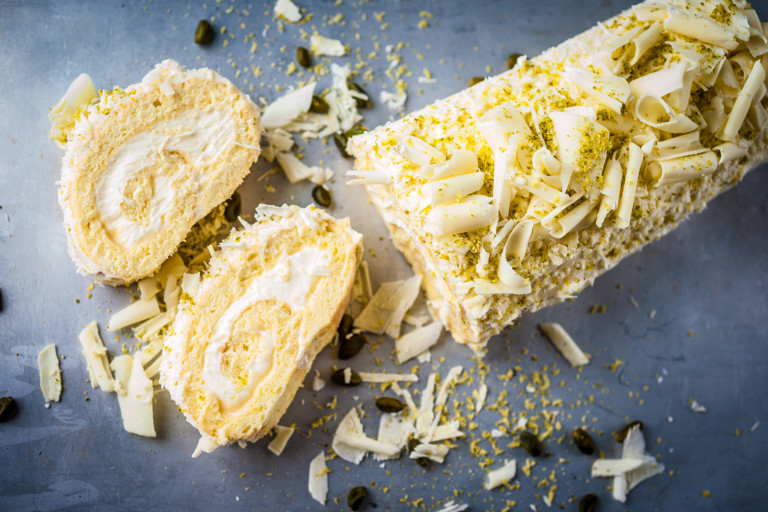White chocolate and lemon roulade
Item 1 of 1
- medium
- 10
- 2 hours
Not everything is as it seems with this show-stopping lemon roulade recipe, as hidden beneath the pillowy sponge is lemon curd and white chocolate mousse. Cake flour is a finely milled white flour made from soft wheat. It has very low protein content (between 8% and 10%), making it suitable for soft-textured cakes and biscuits - perfect for roulades, where a light and flexible sponge is mandatory for successful rolling and shaping.
First published in 2015
discover more:
Ingredients
Metric
Imperial
Lemon curd
- 3 lemons
- 230g of caster sugar
- 250g of unsalted butter, diced
- 4 eggs, whisked together with 1 egg yolk
White chocolate mousse
- 220g of white chocolate, good quality
- 2g of gelatine, approximately
- 330g of double cream
- 30g of semi-skimmed milk
Sponge
To serve
- white chocolate
- pistachio nuts, green
SAVE RECIPE
Equipment
- Sterilised jars
- Silicone paper
- Palette knife
- Swiss roll tin
Method
1
Begin by preparing the white chocolate mousse. Add the white chocolate to a heatproof bowl and melt in the microwave on a low setting. Alternatively, place the heatproof bowl over a pan of gently simmering water and stir until melted
- 220g of white chocolate, good quality
- 2g of gelatine, approximately
2
Soften the gelatine in cold water for 4-5 minutes. Meanwhile, add 120g of the double cream and 10g of the milk to a pan, bring to a simmer, then remove from the heat. Squeeze any excess moisture out of the softened gelatine and add to the cream, stirring until the gelatine has dissolved
- 120g of double cream
- 10g of semi-skimmed milk
3
Add the remaining cream and milk to a bowl and whisk until very soft peaks form. Whisk the warm cream into the melted chocolate to make a ganache, then allow to cool to between 35-40°C. Once it has reached this temperature, fold in the whipped cream. Transfer to a container and allow to set in the fridge for at least 2 hours
- 210g of double cream
- 20g of semi-skimmed milk
4
For the lemon curd, zest the lemons directly into a heatproof bowl to help retain all of the essential oils from the zest - the bowl will need to be the correct size to sit over a pan to make a bain marie
- 3 lemons
5
Firmly roll the zested lemons on a work surface to help them soften and increase the yield when juicing, then squeeze the juices into the bowl with the zest
6
Add the sugar and butter, then place the bowl over a pan of gently simmering water. Allow the mixture to melt together, stirring occasionally to combine
- 230g of caster sugar
- 250g of unsalted butter, diced
7
Once the mix is fully dissolved and fairly warm, whisk in the eggs and egg yolk. Cook the mixture, stirring frequently until thickened - the curd needs to be kept at 79°C for a minimum of 15 seconds to pasteurise the eggs
- 4 eggs, whisked together with 1 egg yolk
8
Pass the curd through a fine sieve and pour into sterilised jars. Seal and allow to cool in the fridge until required. The curd can be kept in the fridge for 4-8 weeks
9
For the sponge, add the duck egg yolks to a bowl and whisk in two thirds of the sugar until thick and pale. Add the whites to a separate bowl and whisk until soft peaks form, then whisk in the remaining sugar. Keep whisking the egg whites until you have a thick and glossy meringue
- 3 duck eggs, separated
- 85g of icing sugar, sifted
10
Preheat the oven to 160°C/gas mark 3
11
Add one third of the meringue into the egg yolk mix and stir to combine. Gently fold in the remaining meringue and once almost combined, gently fold in the sifted flour. Finally, fold through the lemon zest
- 25g of cornflour
- 25g of soft flour, for pastry
- 1 lemon, zest only
12
Line a Swiss roll tin with silicone paper and grease lightly with butter. Dust with a little flour, then tip the sponge mix into the tin, levelling out with a palette knife to ensure an even finish. Place in the oven for 8-10 minutes until risen, firm to the touch and golden
- butter, for greasing
13
Remove the sponge from the oven and sprinkle with caster sugar. Quickly turn out onto a sheet of silicone paper and remove the (now top) layer of paper. Use a sharp pastry knife to neaten the edges and roll up the sponge to form a roulade. Leave the roulade to cool
- caster sugar for dusting
14
Once ready to assemble, carefully unroll the sponge, taking care not to break it. Weigh out 150g of the lemon curd and use a palette knife to spread the curd in an even layer over the sponge, ensuring to leave a 2cm border around the edges
15
Arrange three quarters of the mousse into the centre of the sponge (on top of the lemon curd layer) and work it towards the outer edges, again leaving a 2cm border. Roll up the sponge, enclosing the filling and finishing with the seam at the bottom of the roll
16
Spread a thin layer of the remaining white chocolate mousse over the outer surface of the roulade. Use a knife to shave thick curls of white chocolate, keeping the knife towards you at an angle of approximately 30°
17
Top the roulade with the chocolate curls, then finely grate the green pistachios on top. Place in the fridge to set, removing 1 hour before serving
- pistachio nuts, green
Get in touch
Please sign in or register to send a comment to Great British Chefs.


